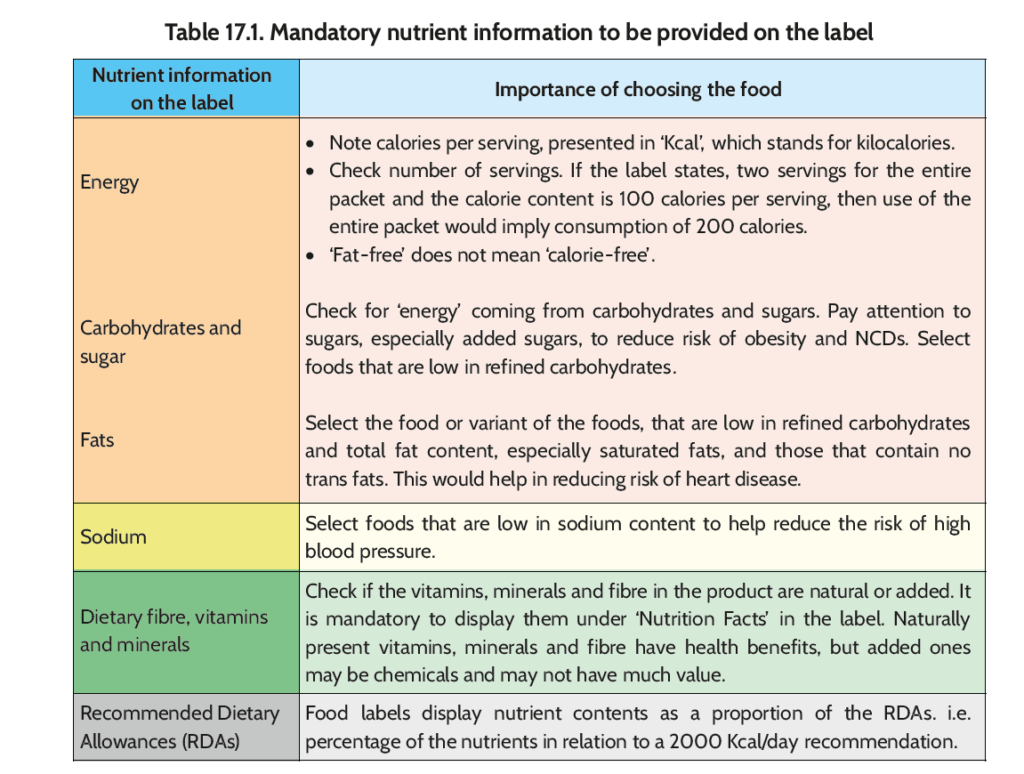A guide to read and interpret information on food labels to make healthy food choices

Food labels provide and hide a lot of information.
In today’s world, most food items are available in pre-packaged form. Therefore, understanding how to read and interpret information on food labels is crucial for making informed and healthy food choices.
Understanding Food Labels
Food labels provide essential details about the contents, ingredients, and nutritional information of the packaged food. Here’s what you can learn from reading food labels:
- Name of the Food: Identifies the product.
- Ingredients List: Displays all ingredients in descending order by weight.
- Net Weight: Indicates the total amount of product.
- Manufacturer Details: Provides the brand name, and the name and address of the manufacturer.
- Dates: Includes the date of manufacture and the use-by or expiry date.
- Storage Instructions: Tells how to store the product.
- Allergen Declaration: Lists any potential allergens.
- Country of Origin: For imported foods, the country of origin and importer’s details are provided.
Ingredient Declaration
Ingredients are listed in descending order, meaning the highest quantity ingredient appears first. This helps consumers understand the primary components of the product.
Nutritional Information
According to Indian regulations, certain nutrient information must be displayed:

- Energy (Kcal)
- Protein (grams)
- Carbohydrates (grams), specifying the quantity of sugar
- Fat (grams), specifying the quantity of saturated fats and trans fats
Always read the nutrition facts to assess the benefits of the specific food items in relation to your nutritional requirements.
Symbols and Logos
Food labels often include various symbols and logos to convey additional information:

- FSSAI Logo: Indicates the manufacturer is licensed by the regulator.
- Vegetarian/Non-Vegetarian Symbols: A green dot in a green square for vegetarian food and a brown triangle in a brown square for non-vegetarian food.
- Fortified Food Logo: Indicates the food has added essential nutrients.
- Vegan Logo: Shows that the food contains no animal-origin ingredients.
- ISI Mark: Mandatory for certain processed foods like infant food and milk.
- AGMARK: Indicates quality in agricultural products like spices and honey.
Assessing Safety and Shelf Life
Always check the date of manufacture and the use-by or expiry date to ensure the product’s freshness and safety. Consuming foods beyond the expiry date increases the risk of food poisoning. Also, follow storage instructions to maintain the product’s quality.
Allergen Information
Food labels include allergen declarations to help individuals avoid ingredients they are allergic to, such as milk, nuts, eggs, fish, soy, and wheat proteins.
Importance of Nutrition Facts
The nutrition facts section is crucial for understanding the nutritional value of the food. Key elements include:
- Serving Size: All nutritional information is based on this amount.
- Net Weight: Indicates the total product amount, with nutrition facts usually based on one serving per 100g/100ml.
- Caloric and Nutrient Content: Helps assess the nutritional value per serving.
Claims on Food Labels
Manufacturers often make various claims on food labels, which can be categorized into:
- Nutrition Claims: Statements suggesting particular nutritional properties, such as “low calorie” or “high fiber.”
- Health Claims: Indications of a relationship between the food and health benefits.
- Risk Reduction Claims: Claims that the food reduces the risk of specific diseases or health conditions.
Misleading Label Claims
Health claims on packaged food can be misleading. For example:
- “All Natural”: May be used loosely, often only indicating minimal processing.
- “Real Fruit”: Can include products with very low fruit content but high added sugars.
- “Made with Whole Grain”: Does not necessarily mean the food is not highly processed.
- “Organic”: Indicates no artificial preservatives, flavors, or colors, and no pesticides or chemical fertilizers.
- “Low Fat or Light”: Often have extra sugar or refined flour, increasing calorie content.
- “No Cholesterol or Heart-Friendly”: Plant-based oils naturally contain no cholesterol but are still 100% fat.
- “Good Source of Protein”: Should be checked for actual nutrient content.
- “Sugar-Free”: May still be high in fats and hidden sugars.
Key Points to Remember
- Read Food Labels: Always check the label to know the contents of the food inside the pack.
- Ingredients Order: Listed in descending order by quantity.
- Nutrient Content: Helps make informed nutritional choices.
- Regulated Claims: Cross-check claims with ingredient lists and nutritional information.
Understanding how to read and interpret information on food labels empowers consumers to make healthier and safer food choices.
Health Disclaimer: This article provides general information only and is not intended to replace professional advice. Contact your nutritionist, healthcare provider, or legal expert for more accurate information. This article is based on the Dietary Guidelines for Indians, published by ICMR-National Institute of Nutrition.








